北京邮电大学计算机学院 离散数学 数学结构 群论 chap9-2
- 格式:ppt
- 大小:439.50 KB
- 文档页数:62
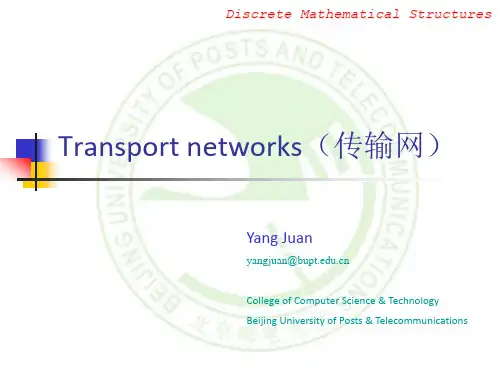
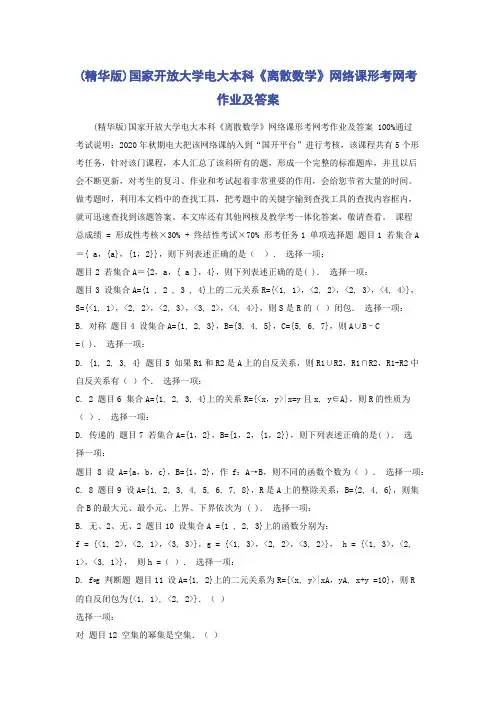
(精华版)国家开放大学电大本科《离散数学》网络课形考网考作业及答案(精华版)国家开放大学电大本科《离散数学》网络课形考网考作业及答案 100%通过考试说明:2020年秋期电大把该网络课纳入到“国开平台”进行考核,该课程共有5个形考任务,针对该门课程,本人汇总了该科所有的题,形成一个完整的标准题库,并且以后会不断更新,对考生的复习、作业和考试起着非常重要的作用,会给您节省大量的时间。
做考题时,利用本文档中的查找工具,把考题中的关键字输到查找工具的查找内容框内,就可迅速查找到该题答案。
本文库还有其他网核及教学考一体化答案,敬请查看。
课程总成绩 = 形成性考核×30% + 终结性考试×70% 形考任务1 单项选择题题目1 若集合A={ a,{a},{1,2}},则下列表述正确的是().选择一项:题目2 若集合A={2,a,{ a },4},则下列表述正确的是( ).选择一项:题目3 设集合A={1 , 2 , 3 , 4}上的二元关系R={<1, 1>,<2, 2>,<2, 3>,<4, 4>},S={<1, 1>,<2, 2>,<2, 3>,<3, 2>,<4, 4>},则S是R的()闭包.选择一项:B. 对称题目4 设集合A={1, 2, 3},B={3, 4, 5},C={5, 6, 7},则A∪B–C=( ).选择一项:D. {1, 2, 3, 4} 题目5 如果R1和R2是A上的自反关系,则R1∪R2,R1∩R2,R1-R2中自反关系有()个.选择一项:C. 2 题目6 集合A={1, 2, 3, 4}上的关系R={<x,y>|x=y且x, y∈A},则R的性质为().选择一项:D. 传递的题目7 若集合A={1,2},B={1,2,{1,2}},则下列表述正确的是( ).选择一项:题目8 设A={a,b,c},B={1,2},作f:A→B,则不同的函数个数为().选择一项:C. 8 题目9 设A={1, 2, 3, 4, 5, 6, 7, 8},R是A上的整除关系,B={2, 4, 6},则集合B的最大元、最小元、上界、下界依次为 ( ).选择一项:B. 无、2、无、2 题目10 设集合A ={1 , 2, 3}上的函数分别为:f = {<1, 2>,<2, 1>,<3, 3>},g = {<1, 3>,<2, 2>,<3, 2>},h = {<1, 3>,<2,1>,<3, 1>},则h =().选择一项:D. f◦g 判断题题目11 设A={1, 2}上的二元关系为R={<x, y>|xA,yA, x+y =10},则R的自反闭包为{<1, 1>, <2, 2>}.()选择一项:对题目12 空集的幂集是空集.()选择一项:错题目13 设A={a, b},B={1, 2},C={a, b},从A到B的函数f={<a, 1>, <b, 2>},从B到C的函数g={<1, b>, <2, a >},则g° f ={<1,2 >, <2,1 >}.()选择一项:错题目14 设集合A={1, 2, 3, 4},B={2, 4, 6, 8},下列关系f = {<1, 8>, <2, 6>,<3, 4>, <4, 2,>}可以构成函数f:.()选择一项:对题目15 设集合A={1, 2, 3},B={2, 3, 4},C={3, 4, 5},则A∩(C-B )= {1, 2, 3, 5}.()选择一项:错题目16 如果R1和R2是A上的自反关系,则、R1∪R2、R1∩R2是自反的.()选择一项:对题目17 设集合A={a, b, c, d},A上的二元关系R={<a, b>, <b, a>, <b, c>, <c, d>},则R具有反自反性质.()选择一项:对题目18 设集合A={1, 2, 3},B={1, 2},则P(A)-P(B )={{3},{1,3},{2,3},{1,2,3}}.()选择一项:对题目19 若集合A = {1,2,3}上的二元关系R={<1, 1>,<1, 2>,<3, 3>},则R是对称的关系.()选择一项:错题目20 设集合A={1, 2, 3, 4 },B={6, 8, 12}, A到B的二元关系R=那么R-1={<6, 3>,<8,4>}.()选择一项:对形考任务2 单项选择题题目1 无向完全图K4是().选择一项:C. 汉密尔顿图题目2 已知一棵无向树T中有8个顶点,4度、3度、2度的分支点各一个,T的树叶数为( ).选择一项:D. 5 题目3 设无向图G的邻接矩阵为则G的边数为( ).选择一项:A. 7 题目4 如图一所示,以下说法正确的是 ( ) .选择一项:C. {(d, e)}是边割集题目5 以下结论正确的是( ).选择一项:C. 树的每条边都是割边题目6 若G是一个欧拉图,则G一定是( ).选择一项:B. 连通图题目7 设图G=<V, E>,v∈V,则下列结论成立的是 ( ) .选择一项:题目8 图G如图三所示,以下说法正确的是 ( ).选择一项:C. {b, c}是点割集题目9 设有向图(a)、(b)、(c)与(d)如图五所示,则下列结论成立的是( ).选择一项:A. (a)是强连通的题目10 设有向图(a)、(b)、(c)与(d)如图六所示,则下列结论成立的是( ).选择一项:D. (d)只是弱连通的判断题题目11 设图G是有6个结点的连通图,结点的总度数为18,则可从G中删去4条边后使之变成树.( ) 选择一项:对题目12 汉密尔顿图一定是欧拉图.( ) 选择一项:错题目13 设连通平面图G的结点数为5,边数为6,则面数为4.( ) 选择一项:错题目14 设G是一个有7个结点16条边的连通图,则G为平面图.( ) 选择一项:错题目15 如图八所示的图G存在一条欧拉回路.( ) 选择一项:错题目16 设图G如图七所示,则图G的点割集是{f}.( ) 选择一项:错题目17 设G是一个图,结点集合为V,边集合为E,则( ) 选择一项:对题目18 设图G是有5个结点的连通图,结点度数总和为10,则可从G中删去6条边后使之变成树.( ) 选择一项:错题目19 如图九所示的图G不是欧拉图而是汉密尔顿图.( ) 选择一项:对题目20 若图G=<V, E>,其中V={ a, b, c, d },E={ (a, b), (a, d),(b, c), (b, d)},则该图中的割边为(b, c).( ) 选择一项:对形考任务3 单项选择题题目1 命题公式的主合取范式是( ).选择一项:题目2 设P:我将去打球,Q:我有时间.命题“我将去打球,仅当我有时间时”符号化为( ).选择一项:题目3 命题公式的主析取范式是( ).选择一项:题目4 下列公式成立的为( ).选择一项:题目5 设A(x):x是书,B(x):x是数学书,则命题“不是所有书都是数学书”可符号化为().选择一项:题目6 前提条件的有效结论是( ).选择一项:B. ┐Q 题目7 命题公式(P∨Q)→R的析取范式是 ( ).选择一项:D. (┐P∧┐Q)∨R 题目8 下列等价公式成立的为( ).选择一项:题目9 下列等价公式成立的为( ).选择一项:题目10 下列公式中 ( )为永真式.选择一项:C. ┐A∧┐B ↔ ┐(A∨B) 判断题题目11 设个体域D={1, 2, 3},A(x)为“x小于3”,则谓词公式(∃x)A(x) 的真值为T.( ) 选择一项:对题目12 设P:小王来学校, Q:他会参加比赛.那么命题“如果小王来学校,则他会参加比赛”符号化的结果为P→Q.( ) 选择一项:对题目13 下面的推理是否正确.( ) (1) (∀x)A(x)→B(x) 前提引入(2) A(y)→B(y) US (1) 选择一项:错题目14 含有三个命题变项P,Q,R的命题公式P∧Q的主析取范式(P∧Q∧R)∨(P∧Q∧┐R).( ) 选择一项:对题目15 命题公式P→(Q∨P)的真值是T.( ) 选择一项:对题目16 命题公式┐P∧P的真值是T.( ) 选择一项:错题目17 谓词公式┐(∀x)P(x)(∃x)┐P(x)成立.( ) 选择一项:对题目18 命题公式┐(P→Q)的主析取范式是P∨┐Q.( ) 选择一项:错题目19 设个体域D={a, b},则谓词公式(∀x)(A(x)∧B(x))消去量词后的等值式为(A(a)∧B(a))∧(A(b)∧B(b)).( ) 选择一项:对题目20 设个体域D={a, b},那么谓词公式(∃x)A(x)∨(∀y)B(y)消去量词后的等值式为A(a)∨B(b).( ) 选择一项:错形考任务4 要求:学生提交作业有以下三种方式可供选择:1. 可将此次作业用A4纸打印出来,手工书写答题,字迹工整,解答题要有解答过程,完成作业后交给辅导教师批阅. 2. 在线提交word文档. 3. 自备答题纸张,将答题过程手工书写,并拍照上传形考任务 5 网上学习行为(学生无需提交作业,占形考总分的10%)附:元宇宙(新兴概念、新型虚实相融的互联网应用和社会形态)元宇宙(Metaverse)是整合了多种新技术而产生的新型虚实相融的互联网应用和社会形态,通过利用科技手段进行链接与创造的,与现实世界映射与交互的虚拟世界,具备新型社会体系的数字生活空间。
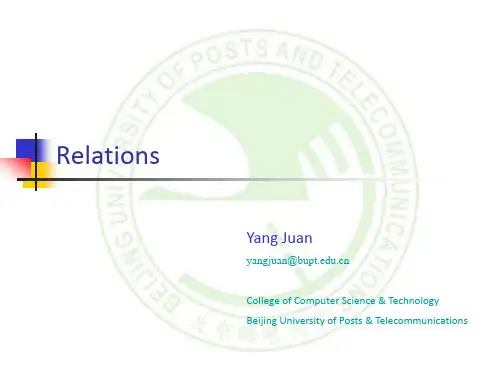
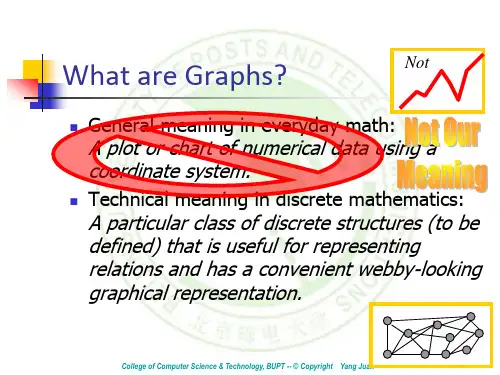
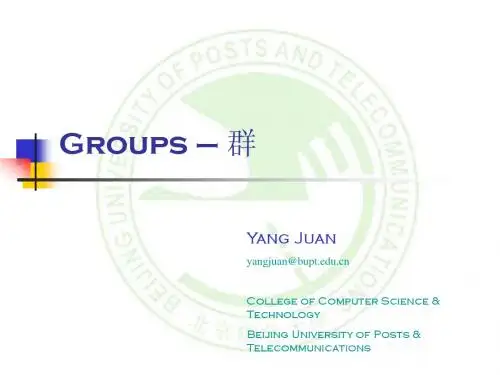
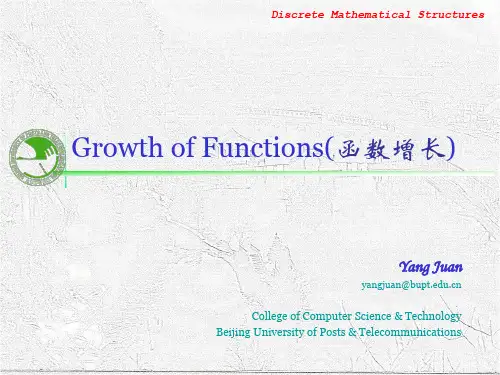


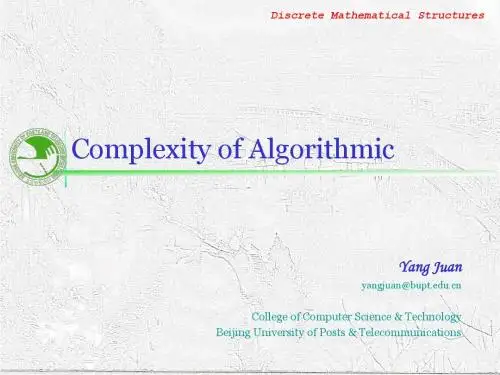
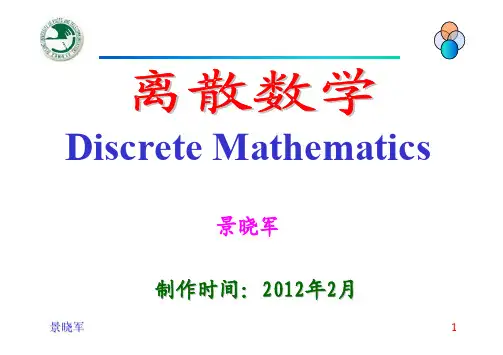
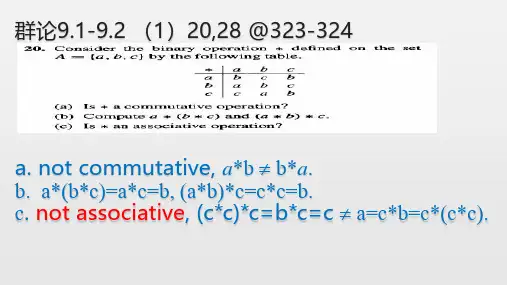
群论9.1-9.2 (1)20,28 @323-324a. not commutative, a*b ≠b*a.b. a*(b*c)=a*c=b, (a*b)*c=c*c=b.c. not associative, (c*c)*c=b*c=c ≠a=c*b=c*(c*c).群论9.1-9.2 (1)20,28 @323-3241. ≤is reflexiveSince a= a*a, a≤a for all a in A.2. ≤is antisymmetricsuppose that a≤b and b≤a.Then, b = a*b= b*a= a, so a= b.3. ≤is transitiveIf a≤b and b≤c, then c= b*c= (a*b)*c= a*(b*c)= a*c, so a≤c.群论9.1-9.2 (1)28 @323-324show a*b= a∨b, for all a and b in A(1)a*b= a*(b*b) =(a*b)*b=b*(a*b), so b ≤a*b.In a similar way, a*b= (a*a)*b=a*(a*b), so a≤a*b.so a*b is a upper bound for a and b.(2)if a≤c and b≤c.then c= a*c and c= b*c by definition. Thus c= a*(b*c)= (a*b)*c. so a*b≤c.This shows that a*b is the leastest upper bound of a and b.群论9.1-9.2 (2)12,16@page 348;︒f1 f2 f3 f4 f5 f6closure;f1 f1 f2 f3 f4 f5 f6identity=f1;f2 f2 f1 f5 f6 f3 f4reverse:f2-1=f2,f3-1=f3, f3 f3 f4 f1 f2 f6 f5f4-1=f5,f6-1=f6.f4 f4 f3 f6 f5 f1 f2associate: ︒is associate.f5 f5 f6 f2 f1 f4 f3f6 f6 f5 f4 f3 f2 f1群论9.1-9.2 (2)12,16@page 348; If a*a=e, ∀a∈G. show commutative.(1)group propertise (a*b)-1=b-1*a-1 because a*a=e=a*a-1 so, b-1*a-1=b*a, (2) (a*b)*(a*b)=e => (a*b)-1=a*b, reverse be only one in Group.so b*a=a*b.群论9.1-9.2 Ex1: Let G be a group. Fora,b∈G,we say that b is conjugate to a,written by b~a, if there exist g∈G such that b=gag-1.show that ~ is a equivalence relation on G. The equivalence classes of are called the conjugacy classes of G.proof: (1)reflexive a=eae, so a~a;(2)symmetric If b~a, then b=gag-1,a=eae=g-1gag-1g=g-1bg.so a~b.(3)transitive suppose a~b and b~c,a=gbg-1 ,b=h ch-1; so a=ghch-1g-1=(gh)c(gh)-1群论9.1-9.2 Ex2: Let G be a group, and suppose that a and b are any elements of G.Show that if (ab)2=a2b2,,then ba=ab.proof:(ab)2=ab*ab=a*(b*a)*ba2b2=aa*bb=a*(a*b)*b,based left/right cancellation, b*a=a*b.群论9.1-9.2 Ex3: Let G ={x∈R|x>1} be the set of all real numbers greater than 1. For x,y∈G, definex*y=xy-x-y+2. Show that (G,*) is a group.proof: (1)closure; because x>1, xy>x+y,so x*y=xy-x-y+2>2, x*y∈G.(2)associate; (x*y)*z=(xy-x-y+2)*z=xyz-xz-yz+2z-(xy-x-y+2)-z+2=xyz-xy-xz-yz+x+y+z .x*(y*z)=x*(yz-y-z+2)=xyz-xy-xz+2x-x-yz+y+z-2+2=xyz-xy-xz-yz+x+y+z .(3)identity: e=2, 2*x=2x-x-2+2=x.(4)reverse: x*x-1=xx-1-x-x-1+2=e=2, x-1=x/(x-1).群论9.4 (1)22,28@page 331;22-Show S 1⋂S 2is a subsemigroup of S.proof: closure; ∀a,b ∈S 1⋂S 2, then a*b ∈S 1, a*b ∈S 2, so a*b ∈S 1⋂S 2.if S 1⋂S 2 =∅, still be subsemigroup.28-If f:S 1→S 2and g :S 2→S 3 be isomorphisms, show g ︒f :S 1→S 3is an isomorphism.proof: (g ︒f)(x *1y)= g(f(x *1y))=g(f(x) *2f(y))=g(f(x))*3g(f(y))=(g ︒f)(x) *3(g ︒f)(y).one-to-one: suppose (g ︒f)(a)=(g ︒f)(b), g(f(a))=g(f(b)), f(a)=f(b), a=b.onto: ∀z ∈S 3 有g(y)=z; ∀y ∈S 2 有f(x)=y;群论9.4 (2)28,32@page 349; 24@page338. 28-Show f:G→G defined by f(a)=a n is a homo morphism.proof: (数学归纳法证)1.because ab=ba, ab*ab=aabb=a2b2,2.(ab)n=a n b n,ab*(ab)n=ab*a n b n=aa n bb n=a n+1b n+1 Hence, f(ab)=(ab)n=a n b n=f(a)f(b).群论9.4 (2)28,32@page 349; 24@page338.32-Show f:G→G by f(a)=a-1 is a isomorphism iff Abelian.Proof: (1)Suppose f is isomorphism,f(xy)=(xy)-1=f(x)f(y)=x-1y-1so xy=((xy)-1)-1=(x-1y-1)-1=yx. G is Abelian. (2)Suppose G is Abelian.f(xy)=(xy)-1=x-1y-1=f(x)f(y), homomorphism. onto: ∀x∈G, f(x-1)=(x-1)-1=x.one-to-one: suppose f(x)=f(y), x-1=y-1,xx-1=e=yy-1, right cancelation x=y.群论9.4 (2)28,32@page 349; 24@page338.24-Let A={0,1} and consider (A*, ⋅), (N,+).(1)f(α)=length(α), show f:A*->N is homomorphism.f(α⋅β)=f(αβ)=length(α)+length(β)=f(α)+f(β)(2)R: f(α)=f(β),show R is congruence relation.First show R is equivalence relation.2. if f(α)=f(β) and f(χ)=f(δ),then f(α⋅χ) = f(β⋅δ)(3)A*/R and N is isomorphic.(A*/R,*) : [α]*[β]=[α⋅β].Let g([α])=length(α), (1)show g: A*/R->N is homomorphism. g([α] *[β])=g([α⋅β])=length(α)+length(β)=g([α])+g([β])(2) onto : ∀x∈N, let α=00…0(x factors) ,g([α])=x.(3) one-to-one : suppose g([α])=g([β]),length(α)=length(β),so f(α)=f(β), then αRβ, [α]=[β].4: Show f:G 1⨯G 2→G 1by f(a,b)=a is a homomorphism. f((a,b )*‘(c,d))=f(a*c,b*d)=a*c=f(a,b)*f(c,d)18: Prove N is normal subgroup iff a -1Na=N for all a ∈G.If N is normal subgroup, then ∀a ∈G, aN=Na, ande ∈N. so a -1Na=Na -1a=Ne=N.If a -1Na=N for all a ∈G, then N=a -1aN=a -1Na,left cancelation, aN=Na.29: Prove H is normal subgroup if H only two left coset.let a∉H, The left cosets of H are H and aH.The right coset are H and Ha.H⋂aH = ∅= H⋂Ha. and H⋃aH=G=H⋃Ha.Thus aH=Ha.let b∈H, bH=H=Hb. so ∀x∈G, xH=Hx.H is a normal subgroup.30: Prove that if N is a normal subgroup of G, then H⋂N is a normal subgroup of H.(1)show H⋂N is a subset of H;∀x∈H⋂N, x ∈H , H⋂N is a subset of H.(2)show H⋂N is a closure;∀x,y∈H⋂N, x∈H and y∈H, x*y∈H; x∈N and y∈N, x*y∈N; so x*y∈H⋂N.(3)Since H and N are subgroup of G, e∈N and e∈H,so e∈H⋂N.(4)∀x∈H⋂N, x ∈H , x-1∈H, and x ∈N, x-1∈N;so x-1∈H⋂N.30: Prove that if N is a normal subgroup of G, thenH ⋂N is a normal subgroup of H.(5) ∀x ∈H, x(H ⋂N) = {xn | n ∈H ⋂N}, let any n 1∈H ⋂N,because aN=Na, x*n 1=n 2*x for some n 2∈N,n 2= x*n 1*x -1,since x -1 ∈H, n 1∈H, then n 2∈H.n 2∈H ⋂N,Thus x(H ⋂N) = (H ⋂N)x.Hence, H ⋂N is a normal subgroup of H.群论9.5 Ex1: Let G be a group, and let N and H be subgroups of G such that N is normal in G. Prove that (1)HN is a subgroup of G.(2)N is normal subgroup of HN.(1) first show HN is closure;∀x,y ∈HN, x=an 1,y=bn 2 for some a,b ∈H.xy=an 1*bn 2, because bN=Nb => n 1*b=bn 3,so xy=abn 3n 2∈HN.e ∈H and e ∈N, so e*e=e ∈HN.∀x ∈HN, x=an 1, x -1=(an 1)-1= n1-1a -1 ,because Nb=bN,so n1-1a -1 =a -1n 4 ∈HN.群论9.5 Ex1: Let G be a group, and let N and H be subgroups of G such that N is normal in G. Prove that(1)HN is a subgroup of G.(2)N is normal subgroup of HN.(2) first show N is subset of HN;∀n∈N, because e∈H, so e*n=n∈HN.Since N is subgroup of G, so N is closed and have identity, and inverse of all elements, thus N is subgroup of HN.Second, show aN=Na, for ∀a∈HN;because (1), a∈G,N is mormal in G, so aN=Na,Hence N is normal subgroup of HN.。
北京邮电⼤学离散数学下群论作业错题讲解群论9.1-9.2 (1)20,28 @323-324a. not commutative, a*b ≠b*a.b. a*(b*c)=a*c=b, (a*b)*c=c*c=b.c. not associative, (c*c)*c=b*c=c ≠a=c*b=c*(c*c).群论9.1-9.2 (1)20,28 @323-3241. ≤is reflexiveSince a= a*a, a≤a for all a in A.2. ≤is antisymmetricsuppose that a≤b and b≤a.Then, b = a*b= b*a= a, so a= b.3. ≤is transitiveIf a≤b and b≤c, then c= b*c= (a*b)*c= a*(b*c)= a*c, so a≤c.群论9.1-9.2 (1)28 @323-324show a*b= a∨b, for all a and b in A(1)a*b= a*(b*b) =(a*b)*b=b*(a*b), so b ≤a*b.In a similar way, a*b= (a*a)*b=a*(a*b), so a≤a*b.so a*b is a upper bound for a and b.(2)if a≤c and b≤c.then c= a*c and c= b*c by definition. Thus c= a*(b*c)= (a*b)*c. so a*b≤c.This shows that a*b is the leastest upper bound of a and b.群论9.1-9.2 (2)12,16@page 348;f1 f2 f3 f4 f5 f6closure;f1 f1 f2 f3 f4 f5 f6identity=f1;f2 f2 f1 f5 f6 f3 f4reverse:f2-1=f2,f3-1=f3, f3 f3 f4 f1 f2 f6 f5f4-1=f5,f6-1=f6.f4 f4 f3 f6 f5 f1 f2associate: ?is associate.f5 f5 f6 f2 f1 f4 f3f6 f6 f5 f4 f3 f2 f1群论9.1-9.2 (2)12,16@page 348; If a*a=e, ?a∈G. show commutative.(1)group propertise (a*b)-1=b-1*a-1 because a*a=e=a*a-1 so, b-1*a-1=b*a, (2) (a*b)*(a*b)=e => (a*b)-1=a*b, reverse be only one in Group.so b*a=a*b.群论9.1-9.2 Ex1: Let G be a group. Fora,b∈G,we say that b is conjugate to a,written by b~a, if there exist g∈G such that b=gag-1.show that ~ is a equivalence relation on G. The equivalence classes of are called the conjugacy classes of G. proof: (1)reflexive a=eae, so a~a;(2)symmetric If b~a, then b=gag-1,a=eae=g-1gag-1g=g-1bg.so a~b.(3)transitive suppose a~b and b~c,a=gbg-1 ,b=h ch-1; so a=ghch-1g-1=(gh)c(gh)-1群论9.1-9.2 Ex2: Let G be a group, and suppose that a and b are any elements of G.Show that if (ab)2=a2b2,,then ba=ab.proof:(ab)2=ab*ab=a*(b*a)*ba2b2=aa*bb=a*(a*b)*b,based left/right cancellation, b*a=a*b.群论9.1-9.2 Ex3: Let G ={x∈R|x>1} be the set of all real numbers greater than 1. For x,y∈G, definex*y=xy-x-y+2. Show that (G,*) is a group.proof: (1)closure; because x>1, xy>x+y,so x*y=xy-x-y+2>2, x*y∈G.(2)associate; (x*y)*z=(xy-x-y+2)*z=xyz-xz-yz+2z-(xy-x-y+2)-z+2=xyz-xy-xz-yz+x+y+z .x*(y*z)=x*(yz-y-z+2)=xyz-xy-xz+2x-x-yz+y+z-2+2=xyz-xy-xz-yz+x+y+z .(3)identity: e=2, 2*x=2x-x-2+2=x.(4)reverse: x*x-1=xx-1-x-x-1+2=e=2, x-1=x/(x-1).群论9.4 (1)22,28@page 331;22-Show S 1?S 2is a subsemigroup of S.proof: closure; ?a,b ∈S 1?S 2, then a*b ∈S 1, a*b ∈S 2, so a*b ∈S 1?S 2.if S 1?S 2 =?, still be subsemigroup.28-If f:S 1→S 2and g :S 2→S 3 be isomorphisms, show g ?f :S 1→S 3is an isomorphism.proof: (g ?f)(x *1y)= g(f(x *1y))=g(f(x) *2f(y))=g(f(x))*3g(f(y))=(g ?f)(x) *3(g ?f)(y).one-to-one: suppose (g ?f)(a)=(g ?f)(b), g(f(a))=g(f(b)), f(a)=f(b), a=b.onto: ?z ∈S 3 有g(y)=z; ?y ∈S 2 有f(x)=y;群论9.4 (2)28,32@page 349; 24@page338. 28-Show f:G→G defined by f(a)=a n is a homo morphism.proof: (数学归纳法证)1.because ab=ba, ab*ab=aabb=a2b2,2.(ab)n=a n b n,ab*(ab)n=ab*a n b n=aa n bb n=a n+1b n+1 Hence, f(ab)=(ab)n=a n b n=f(a)f(b).群论9.4 (2)28,32@page 349; 24@page338.32-Show f:G→G by f(a)=a-1 is a isomorphism iff Abelian.Proof: (1)Suppose f is isomorphism,f(xy)=(xy)-1=f(x)f(y)=x-1y-1so xy=((xy)-1)-1=(x-1y-1)-1=yx. G is Abelian. (2)Suppose G is Abelian.f(xy)=(xy)-1=x-1y-1=f(x)f(y), homomorphism. onto: ?x∈G, f(x-1)=(x-1)-1=x.one-to-one: suppose f(x)=f(y), x-1=y-1,xx-1=e=yy-1, right cancelation x=y.群论9.4 (2)28,32@page 349; 24@page338.24-Let A={0,1} and consider (A*, ?), (N,+).(1)f(α)=length(α), show f:A*->N is homomorphism.f(α?β)=f(αβ)=length(α)+length(β)=f(α)+f(β)(2)R: f(α)=f(β),show R is congruence relation.First show R is equivalence relation.2. if f(α)=f(β) and f(χ)=f(δ),then f(α?χ) = f(β?δ)(3)A*/R and N is isomorphic.(A*/R,*) : [α]*[β]=[α?β].Let g([α])=length(α), (1)show g: A*/R->N is homomorphism. g([α] *[β])=g([α?β])=length(α)+length(β)=g([α])+g([β])(2) onto : ?x∈N, let α=00…0(x factors) ,g([α])=x.(3) one-to-one : suppose g([α])=g([β]),length(α)=length(β),so f(α)=f(β), then αRβ, [α]=[β].4: Show f:G 1?G 2→G 1by f(a,b)=a is a homomorphism. f((a,b )*‘(c,d))=f(a*c,b*d)=a*c=f(a,b)*f(c,d)18: Prove N is normal subgroup iff a -1Na=N for all a ∈G.If N is normal subgroup, then ?a ∈G, aN=Na, ande ∈N. so a -1Na=Na -1a=Ne=N.If a -1Na=N for all a ∈G, then N=a -1aN=a -1Na,left cancelation, aN=Na.29: Prove H is normal subgroup if H only two left coset.let a?H, The left cosets of H are H and aH.The right coset are H and Ha.H?aH = ?= H?Ha. and H?aH=G=H?Ha.Thus aH=Ha.let b∈H, bH=H=Hb. so ?x∈G, xH=Hx.H is a normal subgroup.30: Prove that if N is a normal subgroup of G, then H?N is a normal subgroup of H.(1)show H?N is a subset of H;x∈H?N, x ∈H , H?N is a subset of H.(2)show H?N is a closure;x,y∈H?N, x∈H and y∈H, x*y∈H; x∈N and y∈N, x*y∈N; so x*y∈H?N.(3)Since H and N are subgroup of G, e∈N and e∈H,so e∈H?N.(4)?x∈H?N, x ∈H , x-1∈H, and x ∈N, x-1∈N;so x-1∈H?N.30: Prove that if N is a normal subgroup of G, thenH ?N is a normal subgroup of H.(5) ?x ∈H, x(H ?N) = {xn | n ∈H ?N}, let any n 1∈H ?N,because aN=Na, x*n 1=n 2*x for some n 2∈N,n 2= x*n 1*x -1,since x -1 ∈H, n 1∈H, then n 2∈H.n 2∈H ?N,Thus x(H ?N) = (H ?N)x.Hence, H ?N is a normal subgroup of H.群论9.5 Ex1: Let G be a group, and let N and H be subgroups of G such that N is normal in G. Prove that (1)HN is a subgroup of G.(2)N is normal subgroup of HN.(1) first show HN is closure;x,y ∈HN, x=an 1,y=bn 2 for some a,b ∈H.xy=an 1*bn 2, because bN=Nb => n 1*b=bn 3,so xy=abn 3n 2∈HN.e ∈H and e ∈N, so e*e=e ∈HN.x ∈HN, x=an 1, x -1=(an 1)-1= n1-1a -1 ,because Nb=bN,so n1-1a -1 =a -1n 4 ∈HN.群论9.5 Ex1: Let G be a group, and let N and H be subgroups of G such that N is normal in G. Prove that(1)HN is a subgroup of G.(2)N is normal subgroup of HN.(2) first show N is subset of HN;n∈N, because e∈H, so e*n=n∈HN.Since N is subgroup of G, so N is closed and have identity, and inverse of all elements, thus N is subgroup of HN.Second, show aN=Na, for ?a∈HN;because (1), a∈G,N is mormal in G, so aN=Na,Hence N is normal subgroup of HN.。